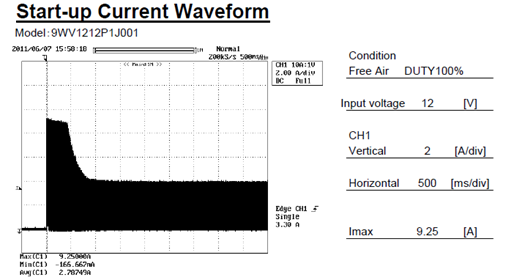Cooling Fan Technology by SANYO DENKI AMERICA
Providing Cooling Solution with High Performance and Reliability
When designing a system, it’s crucial to know the power supply requirements, particularly the worst-case current rating for the DC fans. This article provides an in-depth understanding of what factors need to be taken into consideration.
All DC fan manufacturers provide a nominal rated current, which is based on the fan operating at full speed in an open-air test bench condition. For instance, one of our models shown below has a nominal current rating of 3A at 100% PWM duty cycle on an open test bench.
However, this doesn’t represent the worst-case maximum current value. DC fans, being inductive loads, have a startup current (not to be confused with inrush current) that must be factored in.

Inrush current is a brief current spike that occurs when power is applied to the fan to charge up all the components (primarily capacitors) on the PC board. In the graph below, we see an Imax of 6.5 A but only for a brief time of <20us. This short spike generally has a minimal impact on the power supply supporting the fan and can often be disregarded.

On the other hand, the startup current lasts much longer as it’s needed to overcome the inertia of the fan’s rotor when first powered up. If the fan doesn’t receive the full startup current, it will fail to reach maximum speed and will shut down the motor. Below, we see an Imax startup current of 9.25A for almost 500ms. This has a greater impact on the power demanded by your power supply and must be considered.

The startup current issue is compounded if you have multiple fans turning on simultaneously, requiring a much higher rated power supply. For example, for a two-fan system, if both fans were turned on at the same time, they would require 9.25A x 2 = 18.5A for 500ms. One way to mitigate this issue and use a smaller rated power supply is to stagger or delay powering up the fans so that the second fan powers up after the first fan has reached full speed. This would then only require 3A + 9.25A = 12.25A for 500ms and then be reduced to 3A x 2 = 6A once both fans reached full speed.
In conclusion, the published nominal current rating of the fan is based on operating at full speed and measured under open-air test bench conditions. The inrush current occurs when power is applied to the fan to charge up all the components and is a very short spike.
The start-up current for all DC fans must be considered to ensure your power supply is rated high enough to handle the current. If in doubt about the startup current of a particular fan model, please feel free to contact your local SANYO DENKI AMERICA sales office or your local sales representative for assistance, and we will be glad to help you.
Written by Gary Masessa
SANYO DENKI has been a trusted provider of cooling solutions for various industries, with fans being a crucial component in many advanced devices. Contact us for a quote, or to discuss your device's customization requirements.
Our experienced application engineers and field engineers will provide support on the customization or any other technical support for your equipment. Contact our representatives or distributors to start discussing your next project.
Contact Us